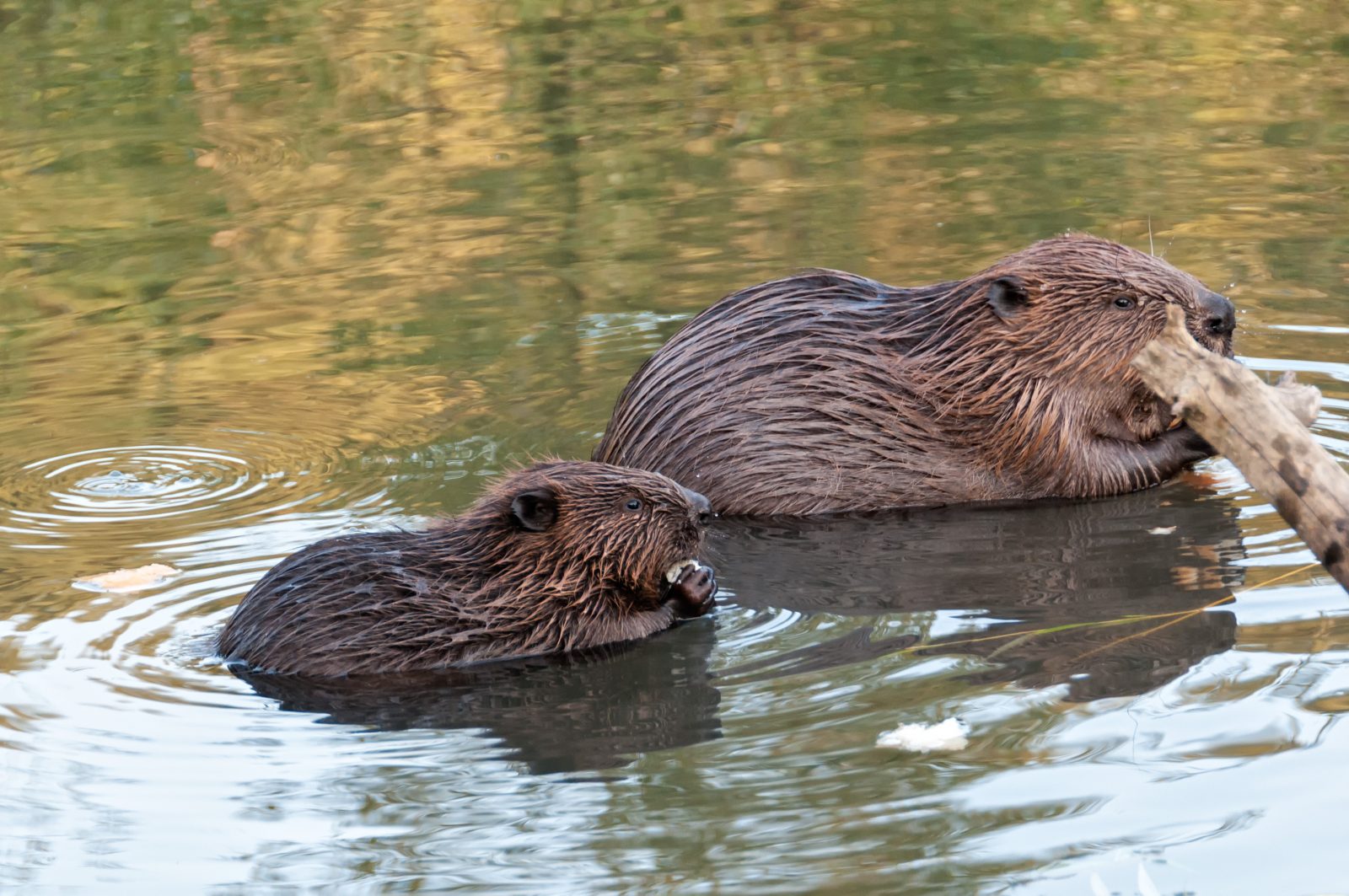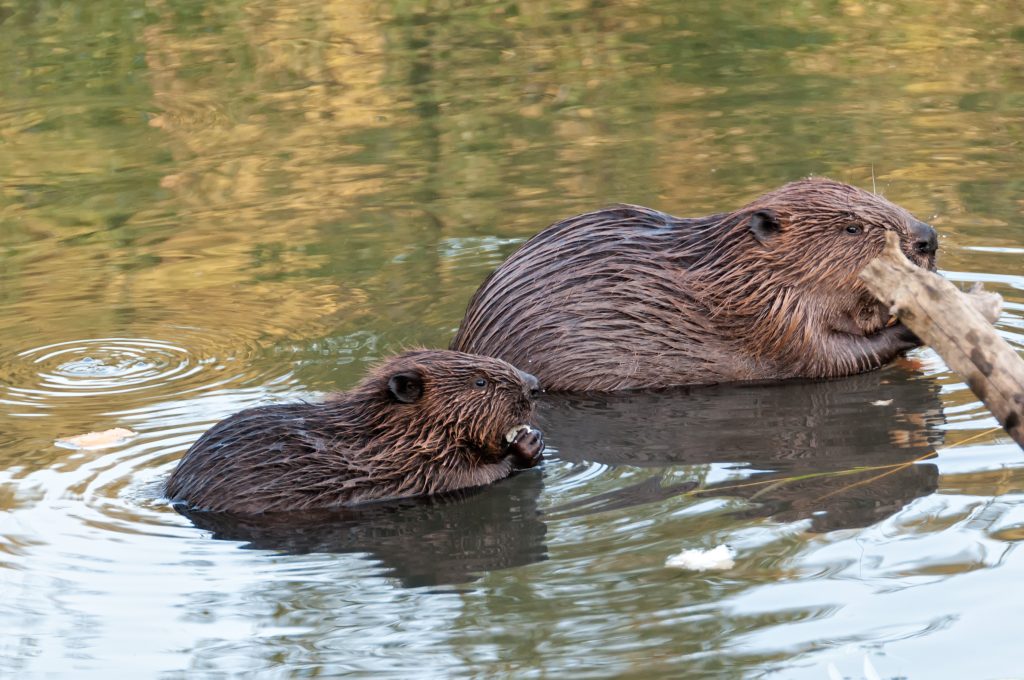Beaver Believers


Beavers are among the most industrious and environmentally impactful animals on earth. Perhaps second only to humans, beavers are born to control their environment, and they are extremely good at it. One might even say, beavers are nature’s watershapers.
By Eric Herman
For as adorable as they may be, beavers are surprisingly controversial. One of the largest rodent species, beavers have long been considered a nuisance, especially by ranchers and others who depend on dry land for their livelihood, creating a sort of beaver conundrum.
Beavers are truly ingenious: they construct complex dams with fallen trees, logs, sticks, stones and mud to create deeper water, which helps them avoid predators. Their lodges have underwater entrances, different rooms, and are remarkably structurally stable and functional. They stockpile food below the surface for winter and raise their young, known as “kits” in near perfect safety.
Beaver dams often flood some areas creating ponds where there were none, and in doing so, they can also deprive water from other places. They don’t draw up blueprints, pull building permits, observe property lines, and they don’t ask anyone’s permission. Beavers are simply pre-wired to do what they do, there is no dissuading them from their dam-building obsession.
Fun Beaver Facts
[] Beavers front teeth don’t stop growing: Beavers are rodents, a bit like mice and rats. All rodents have teeth that grow continuously throughout their life. They need to grind them down to keep them short. Beavers grind their teeth on wood such as tree bark! Their teeth are orange! This is because their enamel has iron in it which makes their teeth strong. [] Beavers can hold their breath underwater for 15 minutes: Beavers spend most of their time in the water. Most humans can only hold their breath for 30 seconds, so that’s pretty impressive! [] Giant beavers existed in the Ice Age: Beavers existed in the Ice Age but they were giant. Growing up to 2.5 meters long. [] They slap their tails on the water to warn family members of danger: Beavers have leathery tails, which they use them for lots of different things like helping them swim, to balance upright and also to store fat for the winter. They also use them to warn family of danger. [] Baby beavers are called “kits”: Beavers usually have one to four kits at a time. [] Beavers have their very own goggles: Beavers don’t have one or three pairs of eyelids. Their third pair of eyelids are transparent. When they are swimmingThat intrepid nature drives some frustrated humans to use dynamite to blow up beaver dams, which the beavers simply rebuild. In some situations, the beavers themselves are eliminated. In response to complaints, the U.S. government killed 25,000 beavers in 2021, according to a report from the New York Times.
But there’s an entirely different side to the trouble with beavers. NYT environmental reporter, Catrin Einhorn writes: “Beavers also store lots of water for free, which is increasingly crucial in the parched West. And they don’t just help with drought. Their engineering subdues torrential floods from heavy rains or snowmelt by slowing water. It reduces erosion and recharges groundwater. And the wetlands beavers create may help to remove excess carbon from the atmosphere.
“In addition to all that, the rodents do environmental double duty, because they also tackle another crisis unleashed by humans: rampant biodiversity loss. Their wetlands are increasingly recognized for creating habitats for myriad species, from salmon to sage grouse.”
Realizing that beavers are, in fact, massively beneficial, some former foes have now become “beaver believers.” In several areas including Colorado, Idaho, Montana, Nevada, Oregon, Utah and Wyoming, the Bureau of Land Management has begun building beaver-like dams with the hope real beavers will take over and expand the installations. In California, legislators have designated $1.5 million a year to restoring beaver populations and habitats for the purpose of drought resistance and biodiversity.
Because beavers create beaver-made wetlands, they contribute to water quality of stream and river systems. Seeing that impact, environmental groups in Maryland are trying to attract beavers to help clean the water that flows into Chesapeake Bay.
And beaver also help minimize the impact of flooding, as mentioned above. In Wisconsin, one study found that beavers have mitigated flooding in some of the most vulnerable areas of Milwaukee County.
As Einhorn reports: “When human-beaver conflicts arise, they can be addressed without killing the animals, experts say. Paint and fencing can protect trees from gnawing. Systems like the Beaver Deceiver secretly undo their handiwork with pipes that drain water from beaver settlements even when the animals keep building. Such measures are actually a more effective solution than removing the animals, according to advocates, because new beavers tend to move into empty habitat. If coexistence is impossible, a growing number of groups and private businesses are seeking to relocate, rather than kill, nuisance beavers.”
More and more, it seems that the day of the beaver has finally arrived. Perhaps we might even learn a thing or two from nature’s adorable and enterprising watershapers.
underwater, they can look through their third transparent eyelids.
[] They are herbivores: Their main diet is plants, grass, bark, twigs and leaves!Source: www.funkidslive.com
Photo by Shujaa77 | Shutterstock









